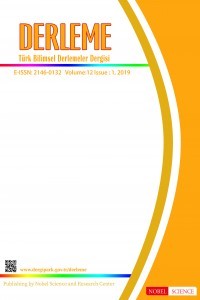Antioxidants and Regulation of Antioxidant Enzymes by Cellular Redox Status
Anahtar Kelimeler:
Free radicals, Oxidative stress, Antioxidant enzymes, Redox regulation
Antioxidants and Regulation of Antioxidant Enzymes by Cellular Redox Status
It has been well known that free radicals have numerous detrimental effects in both in vitro and in vivo in biological systems because of their unavoidable and tremendous reactivity against biological macromolecules especially proteins, carbohydrates and nucleic acids. They are produced in the biological systems continuously by various mechanisms and eliminated by cellular antioxidant systems. If not eliminated sufficiently, or there is a disturbance in their neutralization, inevitable cellular damage may occur. Activities or the presence of antioxidant enzymes in the cells are under strong regulation with transcriptional, translational and post translational mechanisms as a consequence of changes in cellular redox potential. Redox sensitive metabolic enzymes or proteins; such as protein phosphatases, NF-κB and AP-1, are capable of sensing the oxidant signals by reversible oxidation of their regulatory units which cause them to transduce the signal and adjust the cellular antioxidant metabolism. Redox sensitive proteins execute their functions via kinases, phosphatases, and transcription factors influencing the steady state levels of antioxidant enzymes. Therefore, cells may sense, transduce, and translate the oxidant signals into appropriate cellular responses depending on the cellular redox state. This rewiev focused on the basic definitions for the free radicals and the tissue defense mechanism and the possible regulation mechanisms of antioxidant enzymes in the situations undergoing reversible changes in cellular redox status
Keywords:
Free radicals, Oxidative stress, Antioxidant enzymes, Redox regulation,
- Başlangıç: 2008
- Yayıncı: Nobel Bilim ve Araştırma Merkezi Limited
Sayıdaki Diğer Makaleler
Plant Protectıon Products: Markets and The European Union
Karanfil (Dianthus Caryophyllus L.)’ De Görülen Bitki Koruma Problemleri
Mehmet Ali ŞEVİK, İslam SARUHAN
Karkamış Sulak Alanının (Gaziantep-Türkiye) Biyolojik Çeşitliliği
Bitkilerde Markör Destekli Seleksiyon
Tuğba Eserkaya GÜLEÇ, Ahmet YILDIRIM, Özlem Ateş SÖNMEZOĞLU
Antioxidants and Regulation of Antioxidant Enzymes by Cellular Redox Status
Kuş Gribi (Avian İnfluenza) ve Korunma Önlemleri
